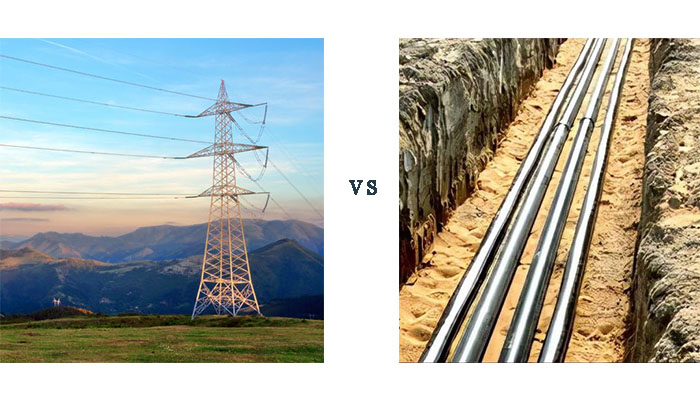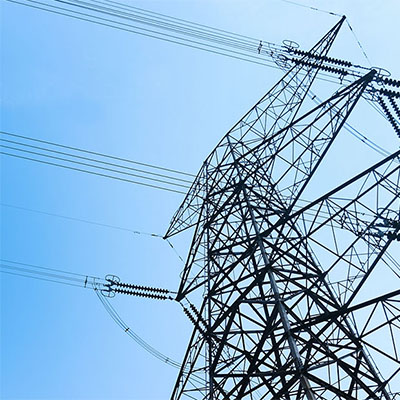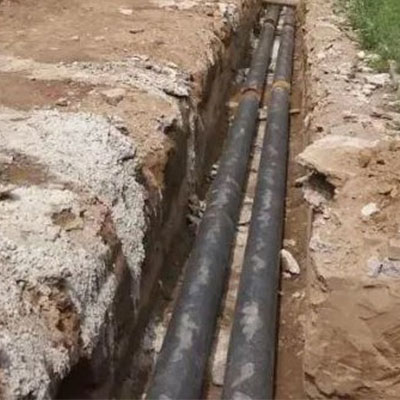- Offices Time:24 Hours Online
- Email:[email protected]
- WhatsApp:+8618339938759

Posted on March 14, 2023
What is the difference between overhead lines and underground cables?
Transmission power cable is a cable used to transmit large amounts of electrical power over long distances. These cables are typically made of copper or aluminum and are insulated to prevent electrical leakage. They are used to connect power generation sources, such as power plants or wind farms, to distribution systems that deliver electricity to homes and businesses.
Transmission power cables are typically designed to operate at high voltages, ranging from 69 kilovolts (kV) to 765 kV or higher. The higher voltage levels are used to reduce power losses over long distances, as power is lost through resistance in the cables. High-voltage transmission cables are also used to connect regional power grids together, allowing electricity to be transferred between regions when needed.
There are two main types of transmission power cables:
1.overhead lines
2.underground cables
Overhead lines are typically used for long-distance transmission, while underground cables are used in densely populated areas where space is limited or where the visual impact of overhead lines is undesirable.

what is overhead lines?
Overhead lines are electrical power transmission and distribution lines that are installed above ground using poles or towers to support the conductors. These lines are also commonly known as power lines, high voltage lines, or transmission lines.
Overhead lines are used to transmit electricity over long distances, from power generation stations to substations, or from one substation to another. The conductors used in overhead lines are usually made of aluminum or copper and are insulated to prevent electrical current from escaping.
Overhead lines can be found in both urban and rural areas, and they are used to provide electricity to homes, businesses, and industries. They are designed to carry high voltages of electricity, which allows large amounts of power to be transmitted over long distances efficiently.

what is underground cables?
Underground cables refers to an electrical power transmission or telecommunications cable that is installed underground, typically in trenches or conduits. Unlike overhead cables that are suspended on poles or towers, underground cables are buried in the ground, which provides greater protection against weather-related damages, vandalism, and other external factors.
Underground cables are typically made up of a conductor, which is usually a copper or aluminum wire, and an insulating layer that surrounds the conductor to prevent current leakage. Depending on their intended use, underground cables may also include additional layers, such as a shield layer, an armor layer, or a protective jacket.
Underground cables are commonly used to transmit electrical power, as well as for telecommunications, such as fiber optic cables used for internet and phone services. They are typically installed by digging a trench or using a specialized cable plow to create a narrow channel in the ground, in which the cable can be placed and covered with soil.
However, overhead lines can also pose some risks, including the potential for electrocution, fires caused by electrical faults, and disruption caused by severe weather events. As a result, overhead lines are often subject to strict safety regulations and maintenance requirements.

What is the difference between overhead lines and underground cables?
Underground cables and overhead cables are two different methods used for power transmission and distribution. Here are some of the main differences:
1.Location
As the name suggests, overhead cables are installed above the ground, while underground cables are buried underground.
2.Cost
Underground cables are generally more expensive to install than overhead cables. This is because underground cables require specialized equipment and labor for digging trenches and burying the cables, while overhead cables can be installed using poles and towers.
3.Maintenance
Overhead cables are exposed to the elements and can be damaged by severe weather conditions such as storms and high winds. They also require regular maintenance to ensure that they remain secure and properly insulated. In contrast, underground cables are protected from the elements and require less maintenance.
4.Aesthetics
Overhead cables can be unsightly and can detract from the appearance of an area, while underground cables are hidden from view and do not affect the aesthetics of an area.
5.Safety
Overhead cables can pose a safety hazard if they come into contact with trees, buildings, or other structures. In contrast, underground cables are generally safer as they are not exposed to the same risks.
6.Reliability
Underground cables are generally considered to be more reliable than overhead cables, as they are not subject to the same types of damage and interference that can affect overhead cables.
7.Environmental Impact
Underground cables have less environmental impact compared to overhead cables as they do not affect the natural landscape and do not require cutting down trees or clearing vegetation to make way for them.
8.Capacity
Overhead cables can generally carry more power compared to underground cables of the same size. This is because underground cables are subject to greater resistance and heat buildup, which can limit their capacity.
9.Durability
Overhead cables can last longer compared to underground cables as they are exposed to fewer hazards and have better ventilation. In contrast, underground cables can be damaged by soil movement, water infiltration, and other factors that can affect their insulation and conductivity.
10.Adaptability
Overhead cables can be easily relocated or rerouted, while underground cables require more effort and cost to be relocated. This makes overhead cables more adaptable to changing circumstances, such as urban development or infrastructure upgrades.
In summary, both underground and overhead cables have their advantages and disadvantages, and the choice between them depends on various factors. While underground cables may offer greater safety, reliability, and environmental benefits, they can also be more expensive and less adaptable compared to overhead cables. Ultimately, the decision between the two will depend on the specific needs and circumstances of the project.
Post categories
Most Popular Posts
-
The 136th Canton Fair welcomes you to participate!
October 12, 2024 -
High temperature cable introduction
July 26, 2024 -
Kenya Power and Energy Exhibition 2024
June 11, 2024 -
Introduction of rubber sheathed cable
June 5, 2024





